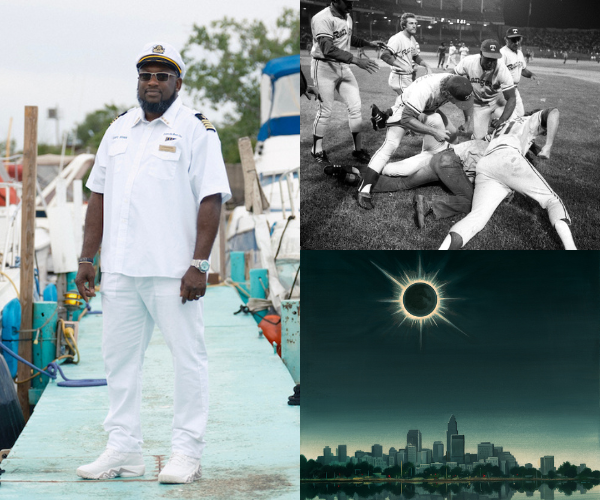Course Correct
by Alex Baca | Sep. 5, 2017 | 1:00 PM

Chelsea Saxman
Near West 41st Street, Platform Beer Co.’s big open windows look out on Lorain Avenue. Inside the beautiful brick building, the taproom’s ethos is best summarized by the name of one of its most popular beers: New Cleveland Palesner. Opened in 2014, Platform helps anchor SoLo, the comically truncated affectation for the area south of Lorain Avenue in Ohio City.
Ben Trimble, Ohio City Inc.’s senior director of real estate and planning, says for the 11 years he’s been in the area, real estate agents have used SoLo to signal to clients that the neighorhood is investment-worthy.
“It’s this weird phenomenon in real estate,” Trimble says. “It’s just a way to talk about things and make people really excited about things that weren’t there before.”
Whatever its beginnings, SoLo stuck. The area block club uses the name; a faux-antique map on Platform’s wall identifies it alongside Cudell, Battery Park, Ohio City, Detroit Shoreway and Edgewater. The name has been ironically mocked over many a pale ale. It even pops up in real estate listings.
The many jokes about SoLo are an indicator of the unrelenting discussion of gentrification in Cleveland. Branded neighborhoods like SoLo make it easy to equate the whole of Cleveland with the few spots with an improved veneer — the Tremonts, Ohio Citys, University Circles.
We are evidently so gripped with worry about gentrification that the City Club of Cleveland has repeatedly made it the topic du jour. It was top of mind during an off-the-record Dinner & Dialogue event at the Black Pig earlier this year. In June, it undergirded a panel conversation about Clark-Fulton, Fairfax and Hough.
In July, Trimble, Famicos Foundation’s Khrys Shefton, Cleveland Neighborhood Progress’ Mordecai Cargill and SoLo block club chair Julia Sieck spoke about it at a panel on the geography of gentrification.
Seated on a stage on the recently renovated Public Square, all seemed to agree: equitable development is good, unrestrained gentrification is bad.
But endless hand-wringing that neighborhoods like SoLo are the second coming of Brooklyn in Cleveland is like using a wrecking ball on an empty lot. All of us well-meaning Cleveland liberals are swinging at the wind. There are bigger problems, ones created by decades of inequitable planning, to be concerned about.
“We are fighting [negative] perception in our neighborhood. We are fighting gunshots in our neighborhood. Those are the things that are critical and important,” says Shefton, whose nonprofit works on housing in Glenville. “People eating, people having employment. All this conversation about gentrification is a distraction about the true issues.”
Much of the concern seems to arise from national media, which highlights the most egregious cost of living increases in places like San Francisco. Locals are following the national trend by wearing their concern on their sleeves.
Yet Cleveland is a far cry from the screaming affordability crises in the Bay Area, Boston and Washington, D.C. On the whole, Cleveland’s housing market is showing promising signs but is still far from healthy.
According to data compiled by Cleveland.com and The Plain Dealer, the median single-family home sale price in Cleveland last year was $33,000. The city’s market is making a comeback, with the fourth straight year in growth and an increase in the number of sales from 3,809 in 2015 to 4,280 in 2016.
It’s not truly apples to apples, but contrast that modest improvement with Cleveland Heights, where the median sale price last year increased by 25 percent, from $78,000 in 2015 to $97,200 in 2016, the best price since the 2007-08 financial crisis, or with the overall Cuyahoga County suburban median of $130,000.
In small pockets of Ohio City, Tremont and even on East 105th Street in Glenville’s Circle North, homes are selling for up to $300,000. An early August Zillow search revealed new SoLo townhomes listed for hedge fund manager-friendly prices of $370,000 and $410,000. But a few blocks south were a smattering of foreclosures and listings for $40,000, $59,000 and $60,000.
Rents are rising in Ohio City, Trimble says, but that doesn’t mean longtime residents are being priced out en masse. “We had a lot of vacant land, underutilized land in Ohio City,” he says. “We still do.”
Rents are going up, but Ohio City Inc. is hoping that by owning as much property as possible and prioritizing affordability, it can mitigate the creep of displacement before it gets too severe. “I think that we have a ton of vacant space that’s being developed and that’s a good thing,” says Trimble.
Problematically, we also can’t even measure whether bands of kombucha-swilling Cleveland Clinic executives are actually forcing longtime residents in Cleveland’s few prosperous pockets from their homes.
“You can tell whether or not there are young white professionals jogging in a previously black neighborhood,” said Cargill during the July panel. “But there doesn’t seem to be a lot of research about who is getting pushed out, if they’re getting pushed out.”
“Having just completed a master plan for a community, [gentrification] is not something that we don’t think about,” Shefton says. “But you know what I think about more? Equity. How can I make this revitalization plan that we say is for everyone, for everyone?”
For Shefton, that means ensuring residents get the construction jobs to building valuable homes those families can live in.
“If you’re upset about pretty pictures and changing the names, you might not be worried about the right stuff,” says Shefton. “No one is including the details in terms of the differences in the neighborhoods that we’re talking about. Ohio City is a 25-year story. Glenville’s story hasn’t been fully realized yet.”
Indeed, most Cleveland neighborhoods are closer to Glenville than to Ohio City.
Further, it’s not clear we’re all freaking out about the same thing. The term “gentrification,” at least among the urbanists that pick this stuff apart for fun, is understood to have little meaning at all. From its progenitor, sociologist Ruth Glass, to academics like Neil Smith and urban culture authors like Richard Florida, everyone hitches their own definition to it.
In everyday conversation, it describes trendy condos and New Cleveland Palesner, rising living costs and that guy in the neighborhood Facebook group being a jerk about a little noise after 10:30 p.m.
Ultimately, it means things that are new or things that are different. And no one is ever comfortable with change.
But change must come to Cleveland if the city is to survive. There are still thousands of people to pull out of eye-popping poverty, a school system to keep on track, funding for public transit to find and decades of disinvestment, segregation and population loss to reverse. The city needs economic growth, the stability for honest-to-god corporate competition, jobs and entrepreneurship.
Cleveland deserves to be considered as a whole. Fretting over managed change in a few neighborhoods, by those who have the privilege of time to speculate, does a disservice to the very real and immediate policy problems that we have failed to solve. Let’s fight something real, rather than a specter.
Trending
-
1
-
2
-
3
-
4
-
5










